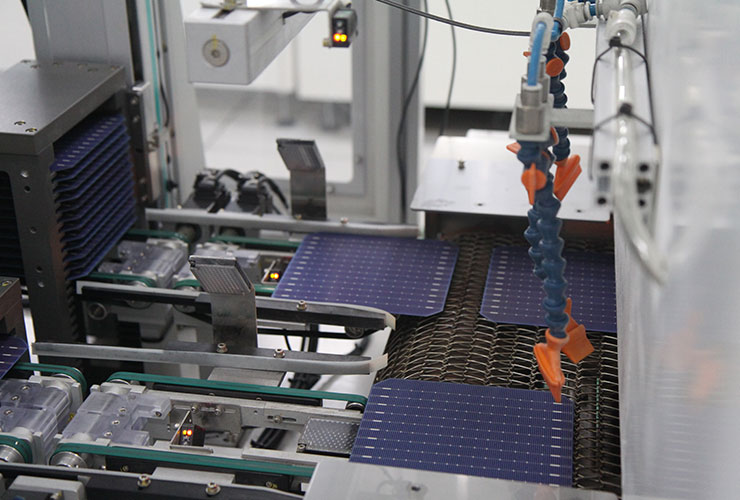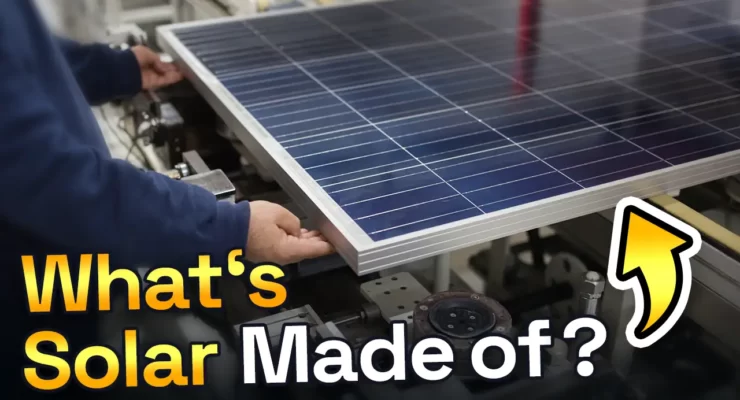Fast read
Solar cells, or PV cells, convert sunlight into electricity using silicon, which is abundant and effective for this purpose. There are three main types of silicon used: monocrystalline, polycrystalline, and thin-film, each offering different efficiencies and applications.
The manufacturing process involves:
- Purifying silicon from silicon dioxide.
- Creating silicon boules.
- Cutting silicon wafers.
- Doping silicon with phosphorus or boron.
- Adding thin electrical contacts.
- Applying an anti-reflective coating.
- Encapsulating the cells in protective materials and assembling them into modules.
Advances in technology promise even greater efficiency and affordability, driving the global shift to renewable energy.
What Are Solar Cells Made Of and How Are They Made?
Solar cells, also called PV cells, are in solar panels. They take in sunlight and change it into electricity. This article delves into what solar cells are made of, the materials used in their construction, and the detailed manufacturing process. Understanding the intricate steps and materials involved can shed light on the remarkable technology that powers solar energy solutions.
Solar cells mostly use silicon, which is plentiful on Earth. Silicon is abundant and works well for solar cells.
Solar cells use various types of silicon, including monocrystalline, polycrystalline, and thin-film silicon. Each type offers different efficiencies and applications.
Monocrystalline Silicon: This type of silicon is made from single-crystal silicon and is known for its high efficiency and longevity. Monocrystalline solar cells are typically more efficient because the single-crystal structure allows for better electron flow.
Polycrystalline Silicon: Polycrystalline cells are made from silicon crystals melted together. They are slightly less efficient than monocrystalline cells but are more cost-effective to produce.
Thin-Film Silicon: Thin-film solar cells use very thin layers of silicon or other photovoltaic materials. They are flexible and can be used in a variety of applications, including building-integrated photovoltaics (BIPV).
The Manufacturing Process of Solar Cells
The manufacturing process of solar cells involves several precise and controlled steps to ensure the highest efficiency and quality.

Step 1: Purifying Silicon
The process begins with silicon dioxide, which is abundant in sand.
Technicians heat silicon dioxide in an electric arc furnace, using a carbon arc to release oxygen. This process results in carbon dioxide and molten silicon. The molten silicon produced is about 99% pure but still needs further purification to be suitable for solar cells.
The purification process uses the floating zone technique. Technicians pass a rod of impure silicon through a heat zone multiple times, driving impurities to one end of the rod with each pass until achieving highly pure silicon.
Step 2: Creating Silicon Boules
This process involves dipping a seed crystal of silicon into molten silicon and slowly pulling it out while rotating. This results in the formation of a cylindrical ingot or boule of single-crystal silicon.
Step 3: Cutting Silicon Wafers
The silicon boule is sliced into thin wafers using a circular saw. These wafers are the basic building blocks of solar cells. The cutting process needs to be precise to ensure uniformity and minimal wastage of silicon.
Step 4: Doping Silicon
To enhance the electrical properties of silicon, technicians use a process called doping. They introduce phosphorus or boron to the silicon wafer.
A newer method involves bombarding the silicon wafer with phosphorus ions using a particle accelerator. This creates a p-n junction, essential for the photovoltaic effect to occur.
Step 5: Adding Electrical Contacts
Thin electrical contacts are added to the surface of the cell, these contacts are crucial for conducting the electricity generated by the cell. They must be fine enough not to block sunlight while effectively conducting electricity.
Step 6: Applying Anti-Reflective Coating
Pure silicon reflects a significant portion of sunlight, causing potential energy loss. To mitigate this, technicians apply an anti-reflective coating to the silicon wafer. Common materials used for this coating include titanium dioxide and silicon oxide.
The sputtering method applies the coating. High voltage removes molecules from the coating material and deposits them onto the silicon wafer.
Step 7: Encapsulating Solar Cells
Finally, manufacturers encapsulate the solar cells using materials like silicon rubber or ethylene-vinyl acetate (EVA) to protect them from environmental damage and ensure durability. They then assemble the encapsulated cells into a solar module, framing it in aluminium for additional protection and stability.
Advances and Future of Solar Cell Technology
Solar power technology is continually evolving, with ongoing research and development leading to improvements in efficiency, cost, and applications. Innovations such as multi-junction solar cells, organic photovoltaics, and perovskite cells are pushing the boundaries of what renewable technology can achieve.
Multi-junction solar cells, for example, use multiple layers of different semiconductor materials to capture a broader spectrum of sunlight, significantly increasing efficiency. Perovskite cells are getting noticed for being more efficient and cheaper to make than silicon-based cells.
Conclusion
Solar cells use silicon as the main material and go through many steps to turn sunlight into a reliable and sustainable energy source. These cells will improve and become more affordable as research and development continue. This will make solar energy more accessible to people worldwide.
By using the latest technologies and better manufacturing processes, the solar industry will play a key role in the global switch to renewable energy. These cells made from new materials are leading the way in the green revolution.
